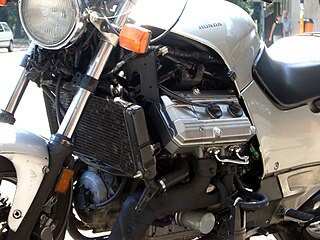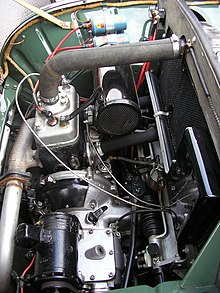
A V4 engine is a four-cylinder piston engine where the cylinders share a common crankshaft and are arranged in a V configuration.

A straight-three engine is a three-cylinder piston engine where cylinders are arranged in a line along a common crankshaft.

The Saab 95 is a seven-seater, two-door station wagon which was produced by Saab from 1959 to 1978.

The Saab 96 is an automobile manufactured and marketed by Saab from 1960 to January 1980, replacing the 93. The 96 featured aerodynamic two-door bodywork, four-passenger seating and at first a two-stroke, three-cylinder engine, later a four-stroke V4.

The Saab Granturismo was a series of up-powered sedans sold by Saab Automobile AB from 1958 to 1968. They were powered by three-cylinder, two-stroke engines until the 1967 model year. Most variants were distinguished from the standard model by twin metal stripes along the rocker panels.

The Saab Sonett is an automobile manufactured between 1955 and 1957 and again between 1966 and 1974 by Saab of Sweden. Sonetts share engines and other components with Saab 93, 95 and 96 of the same era. It was mainly intended for the lucrative American export market and was only offered intermittently in the Swedish domestic market.

The Ford Pinto engine was the unofficial name for a four-cylinder internal combustion engine built by Ford Europe. In Ford sales literature, it was referred to as the EAO or OHC engine and because it was designed to the metric system, it was sometimes called the "metric engine". The internal Ford codename for the unit was the T88-series engine. European Ford service literature refers to it as the Taunus In-Line engine. In North America it was known as the Lima In-Line (LL), or simply the Lima engine due to its being manufactured at Lima Engine in Lima, Ohio.

The Ford Taunus V4 engine is a 60° V4 piston engine with one balance shaft, introduced by Ford Motor Company in Germany in 1962. The German V4 was built in the Cologne plant and powered the Ford Taunus and German versions of the Consul, Capri, and Transit.

The BMW M10 is a SOHC four-cylinder petrol engine which was produced from 1962-1988. It was BMW's first four-cylinder engine since the BMW 309 ended production in 1936 and was introduced in the New Class sedans.

The original Ford Cologne V6 is a series of 60° cast iron block V6 engines produced continuously by the Ford Motor Company in Cologne, Germany, since 1965. Along with the British Ford Essex V6 engine and the U.S. Buick V6 and GMC Truck V6, these were among the first mass-produced V6 engines in the world.

The Ford Sidevalve is a side valve from the British arm of the Ford Motor Company, often also referred to as the "English Sidevalve". The engine had its origins in the 1930s Ford Model Y, and was made in two sizes, 933 cc (56.9 cu in) or "8 HP", and 1,172 cc (71.5 cu in) or "10 HP". The early engines did not have a water pump as standard, instead relying on thermosiphon cooling as the Model T engine had. A water pump was added in 1953 for the 100E models when the engine was re-engineered to the point that few specifications are identical between the early and the later series. The Sidevalve engine was used in many smaller Fords as well as farm vehicles, commercial vehicles and a marine version in boats. Production of the engine was stopped in 1962. Windscreen wipers were often driven by the vacuum generated in the inlet manifold.

The Ferrari Lampredi engine was a naturally aspirated all aluminum 60° V12 engine produced between 1950 and 1959. Inline-4 and Inline-6 variants for racing were derived from it.

The Saab H engine is a redesign of the Saab B engine, which in turn was based on the Triumph Slant-4 engine.

The Nissan L series of automobile engines was produced from 1967 through 1986 in both inline-four and inline-six configurations ranging from 1.3 L to 2.8 L. It is a two-valves per cylinder SOHC non-crossflow engine, with an iron block and an aluminium head. It was the engine of the Datsun 510, Datsun 240Z sports car, and the Nissan Maxima. These engines are known for their reliability, durability, and parts interchangeability.
The Maserati A6GCM is a single seater racing car from the Italian manufacturer Maserati. Developed for Formula Two, 12 cars were built between 1951 and 1953.

The BMW OHV V8 is an overhead valve V8 petrol engine produced from 1954 to 1965. It is BMW's first V8 engine, and BMW did not produce another V8 automobile engine until the BMW M60 in 1992.

The BMW M78 is an overhead valve straight-six petrol engine which was produced from 1933 to 1950. It is the first straight-6 automobile engine produced by BMW, an engine layout which has been a key feature of the brand for many years since.
The 2si 540 and 2si 500 are a family of in-line twin-cylinder, liquid-cooled, two-stroke, dual ignition, aircraft engines that were designed for ultralight aircraft.

The Standard SC engine is a cast-iron overhead valve straight-four engine designed and initially produced by Standard Triumph. Over its production life displacement grew from an initial size of just over 800 cc to nearly 1500 cc. Introduced in the Standard Eight in 1953, it would eventually be used in a wide range of vehicles from Standard, Triumph, and MG.



















